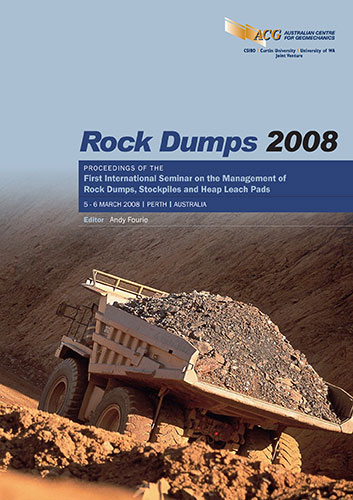The Metamorphism of Dumps into Hills

|
Authors: Jones, H Paper is not available for download Contact Us |
DOI https://doi.org/10.36487/ACG_repo/802_23
Cite As:
Jones, H 2008, 'The Metamorphism of Dumps into Hills', in AB Fourie (ed.), Rock Dumps 2008: Proceedings of the First International Seminar on the Management of Rock Dumps, Stockpiles and Heap Leach Pads, Australian Centre for Geomechanics, Perth, pp. 267-275, https://doi.org/10.36487/ACG_repo/802_23
Abstract:
Standard practice is to place waste materials in close proximity to where they are produced, with little consideration being given to the long-term viability of the landforms being built using this excavated waste. Landforms acceptable to the community at closure are generally those that are not dissimilar, in shape and in scale to the naturally occurring hills of the region. This paper considers what happens to the landforms constructed of excavated waste and tailings after they have been stacked, describes the forces that affect them and demonstrates how sympathetic engineering can accelerate the transformation of waste dumps into hills. The forces include weathering (chemical alteration and mechanical and biological breakdown of rock forming minerals) and erosion. The main agents of erosion are rainfall and wind, which complement weathering by removing materials from one location and transporting them to another. Waste management in individual mining operations will always be primarily driven by the requirement to minimise operating costs, but the long-term cost of not designing waste landforms for long-term stability could far outweigh the short-term cost benefits. Understanding the natural forces that will impact the waste landforms and designing the landforms with those forces in mind will enable companies to optimise the operating and long-term maintenance costs while constructing stable landforms.
References:
Blight, G.E. and Amponsah-Da Costa, F. (1999) In search of the 1000-year tailings dam slope”, SA Civil Engineering,
Oct.
Blight, G.E. (1989) Erosion losses from the surface of gold tailings dams. Journal of the South African Institute of
Mining and Metallurgy, Vol. 89(1), pp. 23-29.
Breaking New Ground The Mining, Minerals and Sustainable Development Project, IIED, 2002 (www.iied.org/mmsd).
Department of Industry and Resources of W.A. (1996) Guidelines for Mining in Arid Environments, Government of
Western Australia, Perth.
Fletcher, M., Malcolm, C., Petersen, A., Jennings, B. and Burnside, D. (1989) Abatement of Dust in the Kalgoorlie
Region by Revegetation of Overburden Stockpiles. MERIWA Report # 44.
Haigh, M.J. (1979) Ground retreat and slope evolution on regraded surface-mine dumps, Waunafon, Gwent, Earth
Surface Processes and Landforms, Vol. 4, pp. 183-189.
Haigh, M.J. (1980) Slope retreat and gullying on revegetated surface mine dumps, Waun Hoscyn, Gwent, Earth Surface
Processes and Landforms, Vol. 5, pp. 77-79.
Jones, H. (2004) The Principles of Landform Evolution. Proceedings Mine Closure - Towards Sustainable Outcomes,
Section 9, Australian Centre for Geomechanics, Perth, 5-6 August 2004.
Myres, K.L., Espell, R. and Burke, K. (2001) Reclamation and Closure of the AA Heap Leach Pad at Barrick’s
Goldstrike Mine, SME Transaction 2001.
Skinner, B.J. and Porter, S.C. (1987) Physical Geology, 1987.
Willgoose, G.R. and Gyasi-Agyei, Y. (1995) New technology in hydrology and erosion modelling for mine
rehabilitation, APCOM XXV Application of Computers and Operations Research in the Minerals Industry,
Brisbane, 10-12 July.
Willgoose, G.R. (2000) Geomorphology/Erosion. In Planning for Mine Closure, Australian Centre for Geomechanics,
Perth.
Wilson, G.W., Williams, D.J. and Rykaart, E.M. (2003) The Integrity of Cover Systems-An Update. AusIMM Bulletin,
Nov/Dec 2003.
Closure and Environmental Impacts
Rock Dumps 2008, Perth, Australia 275
© Copyright 2024, Australian Centre for Geomechanics (ACG), The University of Western Australia. All rights reserved.
View copyright/legal information
Please direct any queries or error reports to repository-acg@uwa.edu.au
View copyright/legal information
Please direct any queries or error reports to repository-acg@uwa.edu.au